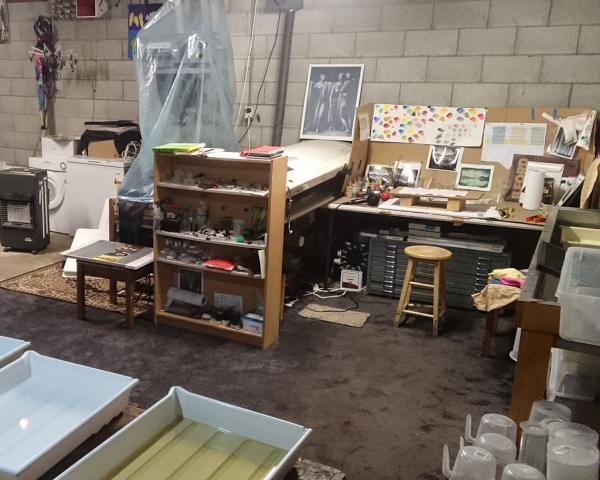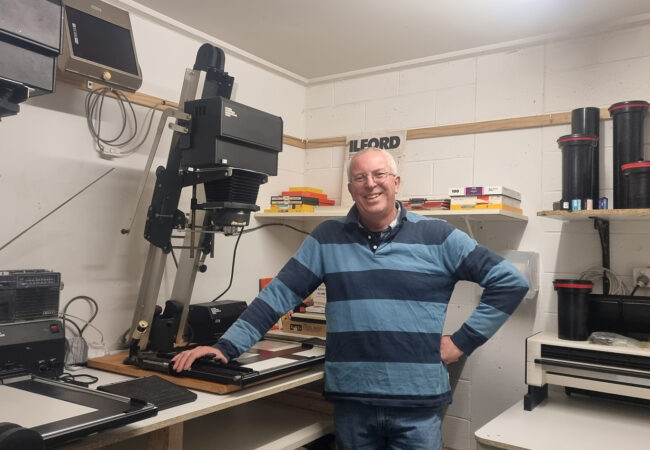
The Photograph Considered number twenty five – Stuart Clook
Kiokio fern. Platinum palladium on vellum over silver leaf
With an invitation to join some keen photography friends for a weekend earlier this year to explore the coast north of Greymouth on New Zealand’s South Island was the perfect excuse to take my new 4 x 5 large format camera into the real world for the first time.
I had only just bought the camera several weeks earlier and although having used a medium format camera for the past couple of years the process of using and managing a large format camera to make pictures I knew would be quite a different challenge. I had been practicing in the back garden and had made a couple of dozen exposures learning how to use the camera and to develop the sheet film so the timing of a weekend trip away was the opportunity that I needed.
On our second day and having explored the beach and tidal areas around Rapahoe in the morning the weather was again uncharacteristically good for the West Coast with little cloud and blue sky giving very harsh and contrasty light. Not the best photography conditions so a couple of us decided to head into the bush along the Queen Elizabeth Walkway to find some shade and hopefully some better conditions for photographing. The bush along this part of the coast is very lush subtropical podocarp forest with a dense undergrowth of shrubs, ferns and mosses. Without the walking track it would be very hard going to make your way through it. After a short while I dropped back and let my friends go on ahead who were on the hunt for orchids and fungi to photograph. I had started to notice that the ferns growing alongside the track were getting larger and more dense the further away we were getting from the beach and I began to concentrate and look out for where they were spilling out on to the track to see if I could make a picture of them.
These Kiokio ferns grow to some five metres high with fonds as long as a couple of meters in length that create a carpet of lush green foliage underneath the matai, nikau palms and other podocarp trees like Rimu and Kahikatea. After a while I found a nice grouping of these ferns growing along a meter-high bank that allowed room for the fonds to cascade down and fully unfold to show off their shiny deep green fronds. Whilst setting the camera up and seeing the sheen on the lighter and younger front fonds I started to think about the printing and how by using my platinum printing on vellum and silver leaf could work in lighting up those younger front fonds against the older more mature ones underneath in the shadows. Not every scene works with this vellum process so I’m always on the lookout for opportunities to add new prints to my collection of intimate landscapes and fauna that I have printed on vellum with either silver or gold leaf to show through the lighter tones to add whole new level of luminosity to the print.
My spot meter showed only 2 to 3 stops between the lighter fronds at the front and those underneath, so I knew I would have to increase development time of the negative to improve the contrast. All my film development up to now had been using the manufactures recommended recipes and times so I made two identical exposures so that I could process them one at a time and use the second one to extend the development time even further if I needed to.
I use a SP-445 tank to develop my negatives with Kodak HC110 developer and ended up developing the negatives with an extra 15% and 30 % over the standard development time of 6 minutes. They both worked well but the 30% negative gave me better separation of the lighter fronds and I used this one to make a digital negative for printing.

My printing for the past several years has been with platinum palladium and gum bichromate which means I need to digitise my negatives so that I can enlarge them using photoshop for printing onto a transparency for contact printing. I had thought about getting a scanner when I bought the LF camera but as I was already getting great results using my DSLR and a macro lens with my medium format negatives, and having already emptied out the piggy bank I decided to use the same setup for my 4x5negatives, at least to begin with. With my Nikon D800e and a Tamron 90mm macro lens I divide the 4 x 5 negative into thirds and take 3 shots of the negative which I place emulsion side up directly onto a LED light tablet. I then stitch the raw files together in LR before bringing it into PS for tonal and contrast adjustments and enlargement. I use Piezography inks and the QTR (Quad tone RIP) driver to print my digital negatives using my Epson 3800.
A contact print is then made on to a piece of sensitised vellum and after drying I then gilded silver leaf onto the back of the vellum. When this is varnished the vellum becomes translucent allowing the silver leaf to shine through the lighter tones in the print and combined with the unevenness in the vellum surface the result is a three dimensional feel to print that works really well in emphasising the flowing wrinkly nature of the ferns fonds.
I am very pleased with the how the print has come out, particularly so as it really is my first successful image from my new camera. The whole experience of working with a large format camera I find totally consuming and although a little frustrating at times is highly rewarding and satisfying.
Camera: Chamonix 45F2, Schneider Apo Symmar 150mm f/5.6 MC and Delta 100 film developed in Kodak HC110 dilution B.
Print: Platinum palladium print on vellum over silver leaf , 11 x 14 inch, edition of 10.

Like a small but growing number of photographers around the world I’m exploring analogue and alternative photographic processes to help me express my thoughts and feelings about the landscape that we live, work and play in. These processes help me make my prints in a uniquely personal way and where I can enjoy using my hands in today’s digital and machine centric world.
I love the fact that results are not always guaranteed and that sometimes serendipity plays her part in the final outcome making for truly unique handmade photographic prints.
My work is represented by Chambers Art Gallery and Magma Gallery in Christchurch.
Stuart Clook’s exhibition Precious Landscapes is showing at Gold Street Studios & Gallery, Trentham, Victoria until 27 October 2019.
Interview with Stuart Clook can be seen here.




Stuart’s exhibition is on at gold street studios to October 27th 2019 – the works is just beautiful – nothing like seeing first hand.